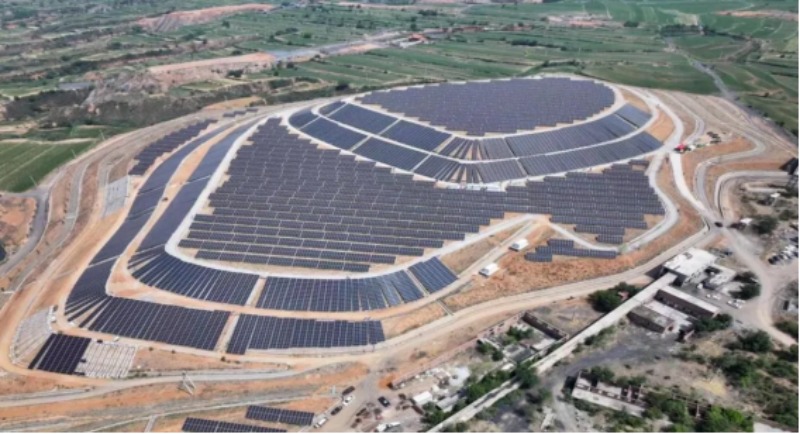Coal gangue hills, formed by long-term accumulation of coal mining waste, not only occupy land resources but also cause environmental pollution, ecological degradation, and socio-economic issues. To explore green regeneration pathways for abandoned mining lands, a research team from the China University of Mining and Technology (Beijing) and Beijing Normal University has proposed an innovative method—integrating Geographic Information Systems (GIS) and the Technique for Order Preference by Similarity to Ideal Solution (TOPSIS)—to scientifically evaluate the feasibility of constructing photovoltaic (PV) power plants on coal gangue hills. This study, recently published in Energy Strategy Reviews, validated the approach using the suburban and mining areas of Yangquan City, Shanxi Province, China, as a case study.

1. Verification project: Wangzhuang Coal Mine in Yangquan, Shanxi
On September 1, 2023, the EPC general contracting project of Shanxi Lu'an Power Distribution Co., Ltd.'s 47MW distributed photovoltaic power generation project (Phase I 25MW) started construction, with a total installed capacity of 24.51MW. The project can generate more than 33 million kWh of clean electricity annually, save about 10000 tons of standard coal, and reduce carbon dioxide emissions by about 26000 tons. On June 26th, the 4.59MW distributed photovoltaic project at the top of the North Gangshan Mountain in Wangzhuang Coal Mine and the 5.63MW distributed photovoltaic project on the slope of the North Gangshan Mountain in Wangzhuang Coal Mine, undertaken by Gansu Construction Investment Installation Company, were successfully connected to the grid, marking the official launch and operation of the first coal gangue mountain ecological restoration photovoltaic project in China.
2. Method Innovation: Synergistic Application of GIS and TOPSIS
The research team developed a multi-level evaluation model, analyzing coal gangue hills through two major dimensions: efficiency indicators (economic, transportation, and geographical requirements) and environmental indicators (natural and living environments). The model incorporated 19 secondary indicators, with efficiency indicators accounting for 92.05% of the total weight (geographical needs: 55.57%, economic needs: 24.33%, transportation needs: 12.15%) and environmental indicators contributing 7.95% (natural environment: 3.36%, living environment: 4.59%).
By combining the Analytic Hierarchy Process (AHP) and the entropy weight method, the team balanced subjective expert experience with objective data optimization to refine weight distributions. For instance, solar radiation intensity, a critical efficiency indicator, held a weight of 22.67%, while proximity to rivers accounted for only 0.66%. Leveraging GIS spatial data analysis, parameters such as terrain slope, solar resources, and transportation accessibility were converted into visual layers. The TOPSIS model then prioritized candidate sites based on their proximity to ideal solutions.
3. Case Study in Yangquan: Five-Level Suitability Classification and Potential Assessment
In the suburban and mining areas of Yangquan City, coal gangue hills were classified into five suitability levels:
Extremely High Suitability: 8 hills, optimal for PV due to sunlight exposure, slope conditions, and infrastructure readiness.
High Suitability: 6 hills with secondary potential.
Medium Suitability: 11 hills requiring design optimization.
Low Suitability: 8 hills.
Not Suitable: 4 hills excluded due to ecological sensitivity or terrain constraints.
The results showed that approximately 30% of the gangue hills held significant potential for PV development, demonstrating the practical value of this methodology.
4. Dual Benefits: Ecological Restoration and Energy Transition
PV plant construction on coal gangue hills not only alleviates land reclamation pressures but also reduces dust pollution and leachate risks through panel coverage. The research highlights three synergistic effects:
Ecological Restoration: PV installations stabilize hill surfaces, curbing soil erosion.
Clean Energy Supply: With a capacity of 50–100 MW per square kilometer, such projects support China’s dual-carbon goals.
Economic Benefits: Utilizing wastelands lowers land costs and enhances industrial value in mining regions.
5. Future: A New Paradigm for Green Revival in Mining Areas
This study offers fresh insights for repurposing abandoned mining lands globally. Next steps include incorporating variables like weather dynamics and energy storage configurations into the model, as well as exploring hybrid models such as "PV + eco-agriculture" and "PV + carbon sink." As China advances its "PV+" strategy, coal gangue hills—once liabilities—could transform into green energy hubs, setting benchmarks for sustainable mining area transitions.

The integration of GIS and TOPSIS not only provides a scientific tool for PV site selection but also pioneers innovative pathways for merging ecological remediation with renewable energy development. Widespread adoption of this framework could accelerate the green revival of mining wastelands worldwide, promoting the transition of energy systems toward low-carbon and circular models.